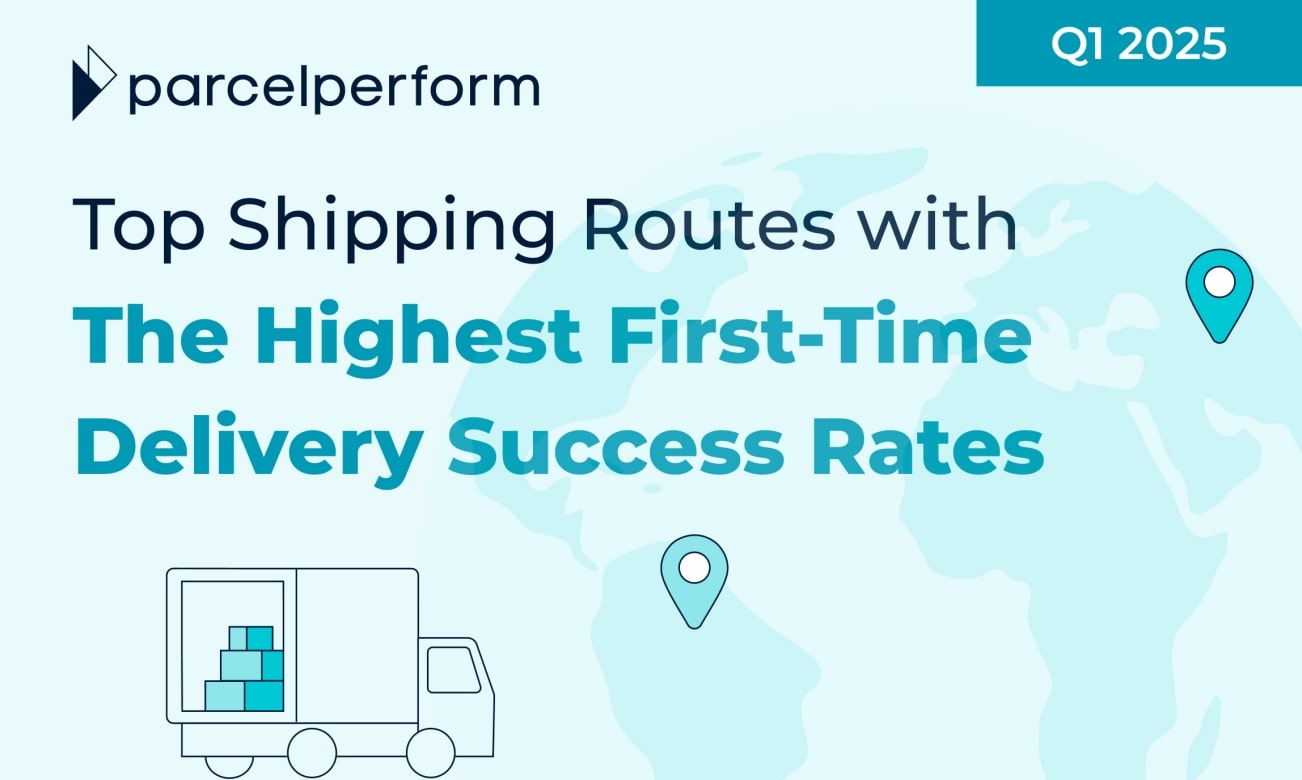Top routes with the highest first-time delivery success rates in Q1 2025
Written by
Editorial TeamPublished on
In Q1 2025, Parcel Perform uncovered the top shipping routes with the highest first-attempt delivery success rates across Europe and the Americas. Which ones? Find out inside! (Ad)

Commercial collaboration
Delivering a package on the first attempt is a vital benchmark in e-commerce logistics. Referred to as the First Attempt Delivery Rate (FADR), this metric reflects how effectively businesses fulfill orders while maintaining customer satisfaction.
Failed deliveries come at a high cost. Statistics show that last-mile delivery, which covers the final leg of a shipment, represents approximately 53% of total shipping expenses. In addition, a survey by Capgemini found that 55% of consumers would switch to a competitor after a poor delivery experience, with failed first-attempt deliveries being a key trigger. This underscores the need to optimize first-attempt delivery rates not only for cost efficiency but also for maintaining customer loyalty. Every unsuccessful delivery triggers additional fuel use, labor, and customer service requirements, further impacting profitability for retailers and logistics providers.
In this article, Parcel Perform examines the top-performing routes for first-attempt delivery success in Q1 2025 across Europe and the Americas. The analysis identifies key elements contributing to these results, offering actionable insights for logistics providers aiming to improve delivery rates, customer satisfaction, and supply chain resilience.
Regional highlights: Leaders in first-attempt delivery performance
Europe: Established markets set the standard

European markets continue to deliver strong results in first-attempt delivery success, particularly within domestic shipping lanes. In Q2 2025, the United Kingdom recorded the highest parcel volume in the region, over 38.3 million shipments, with a first-attempt success rate of 92.9%. This performance is attributed to the country’s mature fulfillment infrastructure, dense delivery networks, and highly efficient postal services.
Switzerland followed closely with 3.67 million parcels delivered domestically and a 92.77% success rate, supported by precise logistics planning and a well-connected transport system. Ireland handled over 1 million parcels, achieving a success rate of 88.07%. These figures highlight the importance of investment in regional distribution networks and technology-driven route optimization.
Overall, Europe’s performance underscores the value of strong domestic logistics systems, streamlined last-mile delivery processes, and intelligent fulfillment strategies to ensure high delivery reliability.
Americas: Costa Rica takes the lead

In the Americas, Costa Rica emerged as the top performer in Q1 2025 with an exceptional 96.15% first-attempt delivery success rate. Despite a lower parcel volume of just 2,128 shipments, its success reflects well-structured delivery networks, efficient route planning, and strong alignment between logistics providers and customer availability.
Peru followed with a 91.96% success rate across 3,943 parcels, boosted by investments in urban logistics infrastructure. Mexico, while managing a significantly higher parcel volume of 187,561, achieved a respectable 87.08% success rate, indicating operational efficiency in high-demand zones with room for further optimization.
What’s behind the surge in first-attempt delivery success?
Successfully delivering packages on the very first attempt goes beyond just fast shipping. It requires careful precision, strategic planning, and intelligent logistics management. Multiple crucial factors contribute to boosting first-attempt delivery rates worldwide, enhancing the overall efficiency and reliability of e-commerce fulfillment.
Automated sorting & Smart warehouses
The quicker a package is sorted and dispatched, the faster it can be delivered to the customer. Utilizing automated sorting systems and smart warehouse technologies helps minimize human errors while accelerating processing speeds. For example, DHL eCommerce recently launched a cutting-edge parcel hub in the UK designed to meet the increasing demand for both domestic and international e-commerce shipments. This advanced facility enhances sorting capacity and sets a new industry standard in parcel automation, enabling faster and more dependable delivery services.
Real-time visibility & notifications
A major cause of missed deliveries is customers not being home when their package arrives. Fortunately, real-time tracking and timely notifications empower shoppers to better manage their deliveries by allowing them to reschedule or redirect packages before the delivery attempt. This proactive communication significantly reduces failed delivery rates.
In Switzerland, for example, Swiss Post’s mobile app enables customers to select alternative pickup options such as parcel lockers or collection points. This service integrates seamlessly with retailers’ systems, simplifying tracking and returns. Globally, major carriers have adopted similar innovations to improve delivery success. FedEx’s Delivery Manager lets customers customize delivery times, locations, or hold packages at nearby lockers, reducing missed deliveries. UPS My Choice offers real-time alerts and allows rerouting or rescheduling, cutting missed deliveries by 20%. Australia Post also offers tracking with options to reschedule, use lockers, or specify safe drop-off spots, enhancing convenience and reducing failed attempts.
Flexible delivery options
Options like parcel lockers, convenient pickup points, and rescheduling tools provide customers with more control over when and where they collect their parcels.
In the UK, InPost operates nearly 9,000 parcel lockers nationwide, allowing easy drop-off and collection points for customers. In 2025, InPost partnered with ASOS to introduce the UK’s first nationwide next-day locker delivery service. This initiative provides ASOS Premier customers free access to 16,000 lockers, enabling them to pick up their orders at their convenience and substantially reducing the chances of missed deliveries.
Smart delivery route planners
Successful deliveries increasingly depend on intelligent route planning rather than just speed. Artificial intelligence (AI) and machine learning (ML) play a critical role in helping logistics companies design the most efficient delivery paths, allowing them to avoid traffic delays, save fuel, and operate more sustainably.
Leading logistics providers such as DPD UK, Royal Mail, and Amazon are investing significantly in AI-powered route optimization tools to enhance the efficiency of last-mile delivery. These systems enable real-time route adjustments, ensuring that packages arrive more promptly and with fewer delays – ultimately boosting the rate of successful first-attempt deliveries.
Integrated logistics collaboration
By utilizing shared infrastructure such as parcel lockers, fulfillment centers, and integrated systems between carriers and retailers, delivery success rates improve significantly.
Retail giants like Amazon and Royal Mail have partnered to expand shared access to services like Amazon Hub Lockers and Royal Mail Parcel Collect, enabling various carriers to tap into the same delivery networks.
DHL, in collaboration with Vanderlande, has developed joint fulfillment centers equipped with robotics and automated sorting systems to serve multiple retailers simultaneously.
In Mexico, Amazon and PackSavvy have rolled out lockers in shopping malls, convenience stores such as OXXO, and residential buildings, making package collection more accessible for customers.
Meanwhile, Switzerland boasts a highly developed locker network, spearheaded by Swiss Post (Post24 lockers) and DPD Switzerland, with units installed in transit stations, retail locations, and residential areas.
Proven ways to achieve first-time delivery accuracy
Ensuring packages are delivered successfully on the first try is essential for boosting customer satisfaction and minimizing operational costs. To increase the likelihood of first-time delivery success, companies must adopt intelligent logistics strategies and empower customers with greater flexibility. Below are four impactful approaches to achieving that goal:
Offer precise estimated delivery dates (EDD) & Ensure address accuracy
Clear and accurate delivery expectations are critical for customer satisfaction. When the estimated delivery date (EDD) is vague or unreliable, customers may hesitate to complete their purchase. Leveraging AI-driven delivery estimates at checkout helps provide more precise arrival times, which builds customer confidence and lowers cart abandonment rates.
Equally important is validating delivery addresses before dispatch. By integrating automated address verification tools into the checkout process, businesses can ensure greater delivery accuracy and increase the chances of a successful first attempt.
Provide flexible delivery options and empower customer control
Allowing customers to select preferred delivery windows, locations, or convenient pickup points puts them in control of their orders and enhances satisfaction.
Additionally, options such as parcel lockers and secure drop-off spots serve as reliable alternatives for package collection when recipients are away. Self-service features like easy rescheduling further enable customers to adjust delivery times as needed, significantly reducing the likelihood of missed deliveries.
Implement proactive communication and rapid issue resolution
Keeping customers well-informed throughout the delivery process is essential. Sending pre-delivery alerts allows recipients to prepare for their package’s arrival. In case of any delays, promptly updating customers with revised estimated delivery times prevents uncertainty and frustration.
When delivery attempts fail, providing straightforward instructions for rescheduling or handling customs clearance streamlines the process. Transparent communication and quick problem-solving not only reduce customer complaints but also contribute to higher overall delivery success rates.
Optimize logistics through adaptive carrier selection and real-time tracking
Instead of focusing solely on cost, businesses should evaluate carriers based on their reliability, speed, and performance in specific regions. Implementing an adaptive carrier selection system ensures the optimal logistics provider is chosen for each delivery route, boosting the chances of successful first-time deliveries.
Additionally, real-time shipment tracking keeps both customers and logistics teams informed throughout the delivery journey. With live visibility, companies can identify potential delays early and proactively address issues to keep shipments on schedule. This transparency also enhances customer confidence, resulting in fewer missed deliveries and improved satisfaction.
Final thoughts
Achieving high first-attempt delivery success is no accident. It results from strategic logistics planning, data-driven decision-making, and prioritizing customer convenience. Leading markets across Europe and the Americas consistently invest in technologies such as automated sorting systems, real-time shipment tracking, flexible delivery options, and AI-powered route optimization. These innovations help reduce failed deliveries, lower operational costs, and enhance overall customer satisfaction.
For businesses and e-commerce carriers aiming to boost first-attempt delivery rates, harnessing advanced logistics data and AI insights is essential. Parcel Perform enables companies to optimize delivery operations, monitor shipments in real time, and provide customers with precise estimated delivery dates.
***


